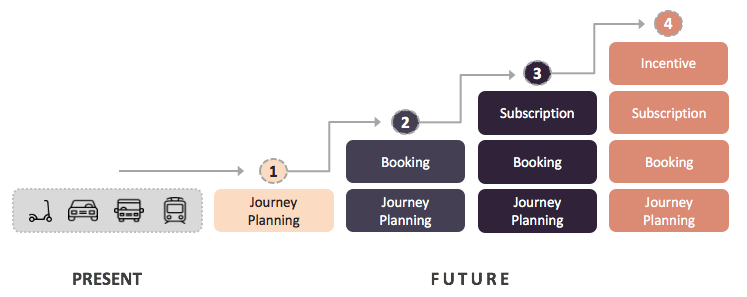The Indian population of 1.3 billion is spread widely across its geographic territory generating a significant gap in demand and supply of transportation needs. The urban cities are considered as a complex structure due to the presence of several transport modes ranging from public, private including the Informal Transportation Modes (IFT) such as Vikrams, cycle-rickshaw, Tata Magics etc. The IFTs are deeply engrained into the Indian transportation structure, besides being cost-effective and flexible they have been instrumental in complementing fixed public transport routes by bridging the existing gaps. However, as India moves towards urbanisation, cycling, walking, public transport, or a combination of these will enable a mobility transition among the urban commuters towards a multimodal transport solution.
In order to effectuate this transition, the metro construction across the cities is in full swing, however there will also be a need to create partnerships with other transport modes so as to promote end to end connectivity at competitive cost. This is crucial for customer satisfaction and inducing a behaviour change from private to shared transportation.
While technology is imperative to aggregate the different transport modes on a single platform, the role of government plays a crucial role in fostering the development of Mobility as a Service (MaaS). The National Urban Transport Policy in 2006, mentions about the creation of an umbrella body Unified Metropolitan Transport Authority (UMTA) in cities with a population of 1 million and above.
MaaS, is a concept that aims to promote collaboration between the public and private transport operators towards creating a platform where all mobility needs of an individual are met on one platform providing an option to plan and pay for their travel.
Public transport is considered an integral part of MaaS platforms, because of the volume it transports each day. MaaS/integrated mobility solution holds the potential to increase the usage of public transportation through enhanced customer experience, achieved through real-time passenger information, traffic management, smart ticketing etc.
UMTA can be considered as the first and the primary step to unify all public transportation modes in the city. While a nationwide implementation of such unified bodies will create an unparallel impact, we are yet to see significant development in this regard. In the meanwhile, there is however a potential for the cities to adopt the enterprise driven solutions and begin with the integration process.
Highlighting on some of the features that constitutes the MaaS platform –
Integration of transport modes:
While integrating various mobility and non-mobility modes (EV charging, Parking, Insurance, Roadside assistance etc) forms the basis of MaaS, accessing these services on one platform through single user account adds to the user convenience.
Use of technology and innovation
Different technologies are combined to make a MaaS platform functional such as e-ticketing and e-payment system, database management system and integrated infrastructure of technologies etc. Additionally, incentivising the customers for using sustainable transport modes can induce a modal shift. Incorporating dedicated dial-in number that can assist the digitally illiterate or older generation to book their intermodal transit journey would promote inclusiveness.
Fare Structure
The most common mode of payment is pay-as-you-go with individual stand-alone single mode fare. The fare structure can take on more innovative forms with monthly passes, or the pre-paid cards such as the National Common Mobility Card (NCMC), will trigger rapid adoption of digital payments across transit use cases improving efficiency and scale of public transit systems in the country. Alternatively, subscription-based model allows different operators to offer their services in bulk by allowing them to be purchased as a package by the commuters, intercity integrated multimodal pricing, and even bundled products with other consumer-based offering.
Data sharing and data privacy
It is next to impossible to provide a personalized travel experience in the absence of open data. A commitment from all the players in the mobility sector to share their data, including ticketing and payments is instrumental for the creation of intermodal journey planning.
The regulatory body (UMTA) should consider establishing clear and fair rules for the management of data and information flow. The ecosystem should ensure transparency on the data flow, usage, accountability and protection norms.
Data Analytics
MaaS platforms can serve as a potential platform to source data on the travel movements of the incumbents thus opening the door to a more efficient use of capacity and new transport management tools. Understanding travel demand is important but predicting travel demand is even more crucial. Through the data analysis tools, it would be possible to better balance the supply to meet demand during peak periods, predict road traffic congestion, capacity utilisation rate for trains or buses, can be effective in influencing the commuters travel behaviour to a great extent.
With the current wave of digitalization impacting the whole economy, the concept of Mobility as a Service (MaaS) is gaining momentum in several countries across the world. MaaS tends to bring benefits to both the passengers who enjoy a seamless experience and to local authorities who can reduce the car usage and promote sustainable transportation in their area. Also transport operators can enhance their mobility offer and access to a broader passenger market. Multimodality is the solution to meet the transport challenges, coupled with the formation of unified regulatory bodies like UMTA in Indian cities will enable the modal shift in the days to follow.






